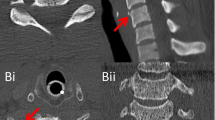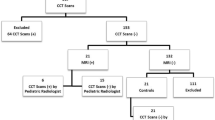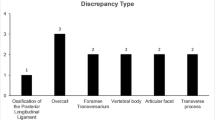Abstract
Purpose
To describe and categorize diagnostic errors in cervical spine CT (CsCT) interpretation performed for trauma and to assess their clinical significance.
Methods
All CsCTs performed for trauma with diagnostic errors that came to our attention based on clinical or imaging follow-up or quality assurance peer review from 2004 to 2017 were included. The number of CsCTs performed at our institution during the same time interval was calculated. Errors were categorized as spinal/extraspinal, involving osseous/soft tissue structures, by anatomical site and level. Images were reviewed by a radiologist and two spine surgeons. For each error, the need for surgery, immobilization, CT angiogram of the neck, and MRI was assessed; if any of these were needed, the error was considered clinically significant.
Results
Of an approximate total 59,000 CsCTs, 56 reports containing diagnostic errors were included. Twelve were extraspinal, and 44 were spinal (26 fractures, 15 intervertebral disc protrusions, two subluxations, one lytic bone lesion). The most common sites of spinal fractures were vertebral body (n = 10) and transverse process (n = 8); the most common levels were C5 (n = 8) and C7 (n = 6). All (n = 26) fractures and two atlantooccipital subluxations were considered clinically significant, including three patients who would have required urgent surgical stabilization (two subluxations and one facet fracture). Two transverse processes fractures did not alter the need for surgical intervention/surgical approach, immobilization, or MRI.
Conclusions
In our study, 66% of spinal diagnostic errors on CsCT were considered clinically significant, potentially altering clinical management. Transverse process and vertebral body fractures were commonly missed.






Similar content being viewed by others
Change history
26 April 2019
The published version of this article unfortunately contained a mistake. Author given and family name Alessandrino Francesco was incorrectly interchanged. The correct presentation is given above. The original article has been corrected.
References
Inaba K, Byerly S, Bush LD, Martin MJ, Martin DT, Peck KA, Barmparas G, Bradley MJ, Hazelton JP, Coimbra R, Choudhry AJ, Brown CV, Ball CG, Cherry-Bukowiec JR, Burlew CC, Joseph B, Dunn J, Minshall CT, Carrick MM, Berg GM, Demetriades D, WTA C-Spine Study Group (2016) Cervical spinal clearance: a prospective Western trauma association multi-institutional trial. J Trauma Acute Care Surg 81(6):1122–1130
Platzer P, Hauswirth N, Jaindl M, Chatwani S, Vecsei V, Gaebler C (2006) Delayed or missed diagnosis of cervical spine injuries. J Trauma 61(1):150–155
Grossman MD, Reilly PM, Gillett T, Gillett D (1999) National survey of the incidence of cervical spine injury and approach to cervical spine clearance in U.S. trauma centers. J Trauma Acute Care Surg 47(4):684
Reid DC, Henderson R, Saboe L, Miller JD (1987) Etiology and clinical course of missed spine fractures. J Trauma 27(9):980–986
Miller CP, Brubacher JW, Biswas D, Lawrence BD, Whang PG, Grauer JN (2011) The incidence of noncontiguous spinal fractures and other traumatic injuries associated with cervical spine fractures: a 10-year experience at an academic medical center. Spine 36(19):1532–1540
Hoffman JR, Mower WR, Wolfson AB, Todd KH, Zucker MI (2000) Validity of a set of clinical criteria to rule out injury to the cervical spine in patients with blunt trauma. N Engl J Med 343(2):94–99
Walters BC, Hadley MN, Hurlbert RJ, Aarabi B, Dhall SS, Gelb DE, Harrigan MR, Rozelle CJ, Ryken TC, Theodore N, American Association of Neurological Surgeons, Congress of Neurological Surgeons (2013) Guidelines for the management of acute cervical spine and spinal cord injuries: 2013 update. Neurosurgery 60(S1):82–91
Stiell IG, Wells GA, Vandemheen KL et al (2001) The Canadian C-spine rule for radiography in alert and stable trauma patients. JAMA 286(15):1841–1848
Martin MJ, Bush LD, Inaba K, Byerly S, Schreiber M, Peck KA, Barmparas G, Menaker J, Hazelton JP, Coimbra R, Zielinski MD, Brown CVR, Ball CG, Cherry-Bukowiec JR, Burlew CC, Dunn J, Minshall CT, Carrick MM, Berg GM, Demetriades D, Long W, WTA C-Spine Study Group (2017) Cervical spine evaluation and clearance in the intoxicated patient: a prospective Western trauma association multi-institutional trial and survey. J Trauma Acute Care Surg 83(6):1032–1040
Simon JB, Schoenfeld AJ, Katz JN, Kamuth A, Wood K, Bono CM, Harris MB (2010) Are “normal” multidetector computed tomographic scans sufficient to allow collar removal in the trauma patient? J Trauma 68(1):103–108
Bush L, Brookshire R, Roche B, Johnson A, Cole F, Karmy-Jones R, Long W, Martin MJ (2016) Evaluation of cervical spine clearance by computed tomographic scan alone in intoxicated patients with blunt trauma. JAMA Surg 151(9):807–813
Munera F, Rivas LA, Nunez DB Jr, Quencer RM (2012) Imaging evaluation of adult spinal injuries: emphasis on multidetector CT in cervical spine trauma. Radiology 263(3):645–660
Nuñez DB Jr, Zuluaga A, Fuentes-Bernardo DA, Rivas LA, Becerra JL (1996) Cervical spine trauma: how much more do we learn by routinely using helical CT? Radiographics 16(6):1307–1318
Bruno MA, Walker EA, Abujudeh HH (2015) Understanding and confronting our mistakes: the epidemiology of error in radiology and strategies for error reduction. Radiographics 35(6):1668–1676
Brady A (2016) Error and discrepancy in radiology: inevitable or avoidable? Insights Imaging 8(1):171–182
Kachalia A, Gandhi TK, Puopolo AL et al (2007) Missed and delayed diagnoses in the emergency department: a study of closed malpractice claims from 4 liability insurers. Ann Emerg Med 49(2):196–205
Fisher BM, Cowles S, Matulich JR, Evanson BG, Vega D, Dissanaike S (2013) Is magnetic resonance imaging in addition to a computed tomographic scan necessary to identify clinically significant cervical spine injuries in obtunded blunt trauma patients? Am J Surg 206(6):987–993
Malhotra A, Durand D, Wu X, Geng B, Abbed K, Nunez DB, Sanelli P (2018) Utility of MRI for cervical spine clearance in blunt trauma patients after a negative CT. Eur Radiol 28(7):2823–2829
Mohamed MA, Majeske KD, Sachwani-Daswani G, Coffey D, Elghawy KM, Pham A, Scholten D, Wilson KL, Mercer L, McCann ML (2016) Impact of MRI on changing management of the cervical spine in blunt trauma patients with a “negative” CT scan. Trauma Surg Acute Care Open 1(1):e000016
Kim YW, Mansfield LT (2014) Fool me twice: delayed diagnoses in radiology with emphasis on perpetuated errors. AJR Am J Roentgenol 202(3):465–470
Jaeschke R, Singer J, Guyatt GH (1989) Measurement of health status. Ascertaining the minimal clinically important difference. Control Clin Trials 10(4):407–415
Hennessy D, Widder S, Zygun D, Hurlbert RJ, Burrowes P, Kortbeek JB (2010) Cervical spine clearance in obtunded blunt trauma patients: a prospective study. J Trauma 68(3):576–582
Milby AH, Halpern CH, Guo W, Stein SC (2008) Prevalence of cervical spinal injury in trauma. Neurosurg Focus 25(5):E10
Yan YY, Khoo JN, Tan TJ, Francis J, Chong LR, Chan EH (2018) Reporting of CT cervical spine after office hours by radiology trainees-analysis of discrepancy rates and RADPEER scores. Emerg Radiol 25(4):399–406
Gebauer G, Osterman M, Harrop J, Vaccaro A (2012) Spinal cord injury resulting from injury missed on CT scan: the danger of relying on CT alone for collar removal. Clin Orthop Relat Res 470(6):1652–1657
Khalilzadeh O, Rahimian M, Batchu V, Vadvala HV, Novelline RA, Choy G (2015) Effectiveness of second-opinion radiology consultations to reassess the cervical spine CT scans: a study on trauma patients referred to a tertiary-care hospital. Diagn Interv Radiol 21(5):423–427
Medow MA, Lucey CR (2011) A qualitative approach to Bayes’ theorem. Evid Based Med 16(6):163–167
Khoo JN, Chong le R, Chan EH, Poh AC (2011) Pitfalls in multidetector computed tomography imaging of traumatic spinal injuries. Emerg Radiol 18(6):551–562
Schotanus M, van Middendorp JJ, Hosman AJ (2010) Isolated transverse process fractures of the subaxial cervical spine: a clinically insignificant injury or not?: a prospective, longitudinal analysis in a consecutive high-energy blunt trauma population. Spine (Phila Pa 1976) 35(19):E965–E970
Brommeland T, Helseth E, Aarhus M, Moen KG, Dyrskog S, Bergholt B, Olivecrona Z, Jeppesen E (2018) Best practice guidelines for blunt cerebrovascular injury (BCVI). Scand J Trauma Resusc Emerg Med 26(1):90
Author information
Authors and Affiliations
Corresponding author
Ethics declarations
Conflict of interest
Alessandrino Francesco, MD: no conflicts of interests.
Christopher M. Bono, MD: North American Spine Society, Editor in Chief Stipend, The Spine Journal; Wolters Kluwer, royalties for edited book; Elsevier, royalties for edited book.
Christopher A. Potter, MD: no conflicts of interests.
Mitchel B. Harris MD: no conflicts of interests.
Aaron D. Sodickson, MD PhD: no conflicts of interests.
Bharti Khurana, MD: book royalties from Cambridge University Press.
Ethical approval
All procedures performed in studies involving human participants were in accordance with the ethical standards of the institutional and/or national research committee and with the 1964 Helsinki declaration and its later amendments or comparable ethical standards.
Informed consent
For this type of study, formal consent is not required.
Additional information
Publisher’s note
Springer Nature remains neutral with regard to jurisdictional claims in published maps and institutional affiliations.
The original version of this article was revised: The published version of this article unfortunately contained a mistake. Author given and family name Alessandrino Francesco was incorrectly interchanged. The correct presentation is given above.
Rights and permissions
About this article
Cite this article
Alessandrino, F., Bono, C.M., Potter, C.A. et al. Spectrum of diagnostic errors in cervical spine trauma imaging and their clinical significance. Emerg Radiol 26, 409–416 (2019). https://doi.org/10.1007/s10140-019-01685-0
Received:
Accepted:
Published:
Issue Date:
DOI: https://doi.org/10.1007/s10140-019-01685-0




